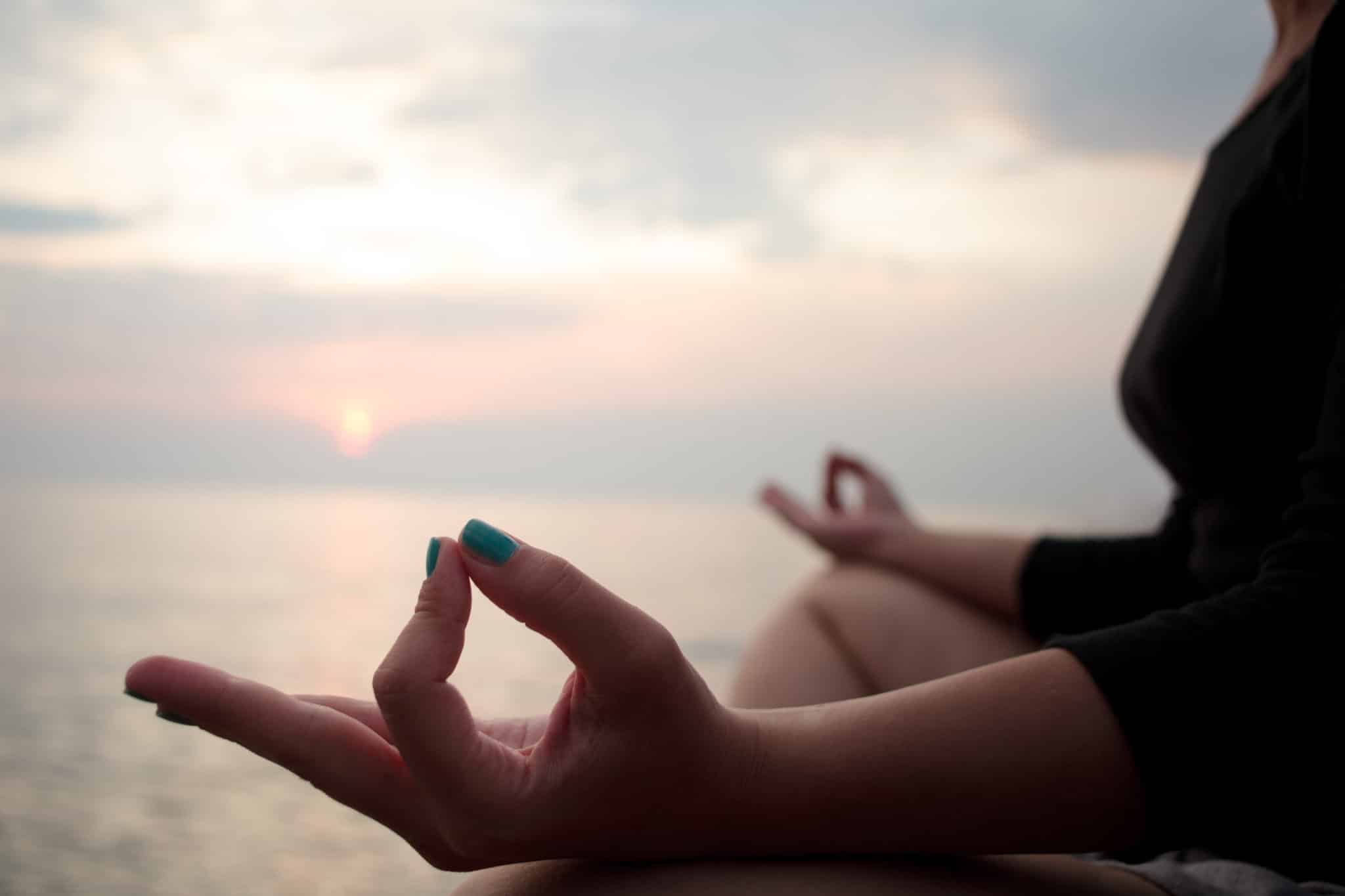When you hear the word “meditation,” what do you think of? Many people don’t know that there are different types of meditation and if one type doesn’t work for you there may be another type of meditation that does.
Free from the distractions of cell phones or conversation, our minds can flood with the subconscious worries, longings, and concerns of day-to-day life. But it’s by sitting with those thoughts and watching them come—and eventually go—that we can calm our bodies and minds, finding peace. And the truth is, there is no one-size-fits-all meditation; meditation comes in just about as many variations as you can imagine.
There are meditation practices based on mindfulness, ones where you repeat mantras, and others that are focused on sending kindness out into the world. But despite their differences, all meditation practices have a common goal: to clear your mind as a method of relaxation. The purpose of any meditation is not to get rid of thoughts—not possible!—but to observe those thoughts without getting attached to them. While meditation itself is not religious, Buddhist philosophy has used it for thousands of years as a core belief of Buddhism is that attachment is a cause of suffering.
When you say to yourself “I had a bad day, I’m no good at anything,” it is not necessarily the thought that causes you suffering, but your belief in that thought and your attachment to it. We all have these types of negative thoughts and feelings from time to time, and being human, we will never eliminate them. But mediation can help us observe thoughts and feelings without being attached to them, and by doing so we can sink into a more relaxed state of being.
Benefits of Meditation
In addition to promoting a general sense of calm, meditation offers some amazing health benefits that have been studied and documented throughout the years. WebMD lists several science-backed health benefits of meditation, including the fact that meditation can:
- lower blood pressure
- boost your immune system
- improve concentration
- improve your physical and emotional response to stress
- decrease inflammation and pain
- decrease anxiety and depression
- improve memory
So, now you’re definitely ready to try meditating, right? Let’s explore how to find the best type of meditation for you.
Related: Beginners Meditation | A Step-By-Step Guide
5 Different Types of Meditation
The best meditation practice—just like the best exercise routine—is the one that you enjoy doing. There is no one-size-fits-all practice. There are multiple meditation styles and formats you can follow, from centuries-old practices to newer styles trail-blazed by modern thought leaders. Some involve mantras, some can be done while taking a stroll in the park, and some require nothing but a deep awareness of each breath you take. So what meditation style will suit you best? Let’s find out.
1. Mindfulness-Based Stress Reduction Meditation

When you’re walking, just walk. When you’re eating, just eat.
What it is: Made popular by Jon Kabat-Zinn in 1979, MBSR or Mindfulness-Based Stress Reduction is about breath awareness and a “body scan.” Breath awareness is simply the act of calmly noticing each inhale and exhale, so your breath is the main focus. A body scan is a technique used to focus on physical sensations in the body. Starting at your toes and working your way up, you focus on specific parts of your body at a time; this heightened awareness has the potential to release and relax tension in different areas.
MBSR has gained increasing popularity over the past few decades and is now offered in over 200 hospitals and medical centers around the world. Kabat-Zinn even leads workshops where his students practice walking meditations, noticing each step mindfully and harkening back to the ancient expression: “when you’re walking, just walk. When you’re eating, just eat.” Kabat-Zinn believes each activity can be done mindfully, and in doing so, you can adopt a more meditative state in your day-to-day life.
Pose: Seated, laying down, or walking
Try if: You want to live more mindfully during each moment of your life, whether when enjoying your meals or walking through the park.
Resources:
- A History of MBSR: Learn more about Mindfulness-Based Stress Reduction
2. Transcendental Meditation

What it is: You may have heard of Transcendental Meditation or TM because it was made popular by some famous followers (the Beatles, for example) but it’s a thousands-of-years-old tradition originally brought to America by Maharishi Mahesh Yogi in the 1950s. Transcendental meditation asks that you sit still for twenty minutes, twice a day, and utilize a mantra to find focus during meditation.
Twenty minutes may sound like a lot at first, but the length of time is designed to help you access a deeper level of calm that exists beyond your everyday emotions and the stress of life. If you choose to enroll in a TM class, your instructor or teacher can give you a mantra and it’s yours to repeat throughout your meditation.
Pose: Seated
Try if: You feel restless, overly stressed, or mentally fatigued and want to experience a deeper sense of inner calm.
Resources:
- Transcendental Meditation Technique: Read more about the origins of Transcendental Meditation and how to find a teacher.
- The Benefits of Transcendental Meditation: Learn what WebMD has to say about the science-backed benefits of TM.
3. Loving-Kindness Meditation

May you be happy. May you be well. May you be safe. May you be peaceful and at ease.
What it is: The cultivation of compassion for others is a popular form of meditation in Buddhism, although loving-kindness meditation itself is not tied to any one religion or philosophy. It’s also sometimes referred to as Metta Meditation. You begin by taking two or three deep breaths with slow, long exhalations, feeling the breath moving through the center of your chest—your heart chakra. You then repeat the following or similar phrase directed at yourself:
May I be happy. May I be well. May I be safe. May I be peaceful and at ease.
After a period of directing loving-kindness to yourself, bring to mind a friend or someone in your life who has cared for you. Then slowly repeat the phrases toward them.
May you be happy. May you be well. May you be safe. May you be peaceful and at ease.
Then direct your attention to the universe—ask that all its beings are happy, well, safe, peaceful and at ease. Connect with any feelings of warmth and unity you experience.
Pose: Seated
Try if: You want to cultivate greater compassion for yourself and others.
Resources and apps:
- Instructions for Loving Kindness Meditation: Helpful tips and philosophies from the Metta Institute.
4. Zazen Meditation

What it is: Zazen meditation is the practice at the heart of Zen Buddhism, and its main focus is on the relationship between the breath and the mind. Practitioners are encouraged to turn their attention to each inhalation and exhalation, counting their breaths at times to achieve greater mental focus. As you inhale, count to one; the exhale is two. Your next inhale is three; the following exhale is four, and so on. Try to just focus on counting each breath, and let that be your mind’s solitary task. Zen meditation can be practiced in groups and sometimes chanting is involved.
Pose: There are several variations of Zazen meditation poses:
- Both legs crossed so each leg rests on the opposite thigh (full lotus)
- One leg resting over the opposite calf (half-lotus)
- On your knees with legs folded under you
- Sit in a straight-back chair
Try if: You want to experience deep relaxation through your breath.
Resources:
- Introduction to Zazen Meditation: Read about the history of Zazen meditation and the different poses to choose from.
5. Vipassana Meditation

Vipassana meditation is not just seeing the things inside; it is also seeing the seer.
What it is: This Sanskrit word means “to see things as they really are” and is also referred to as “insight meditation.” It is part of a 2,5000-year-old Buddhist tradition designed to help you tap into a deeper level of consciousness. In Vipassana you are instructed to label thoughts and experiences as they arise, noting objects that grab your attention. Each time you identify a label in your mind, you are then encouraged to bring your awareness back to your primary object: your breath. Focus on your breath from moment to moment. Any time a thought, feeling, or sensation, comes into your mind, note it as “dog barking” or “knee pain” or “thinking” and then return your focus to your breath. This allows you to become the observer of your thoughts, helping you see them more objectively.
Pose: Cross-legged on a cushion on the floor.
Try if: You want to release harmful thoughts and expand your consciousness.
Resources:
- An Introduction to Vipassana Meditation: Discover the history of Vipassana and how to practice it.
READ THIS NEXT: Choose Meditation Over Medication

